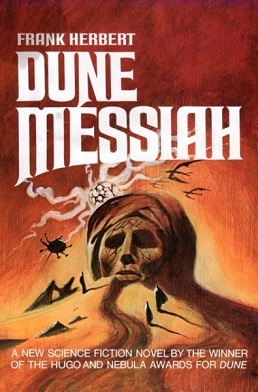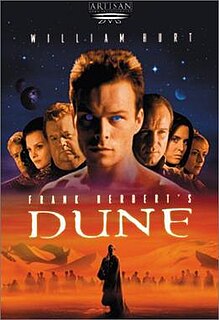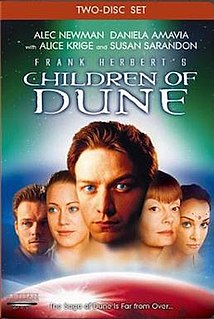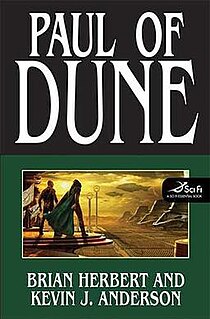Related Research Articles

Children of Dune is a 1976 science fiction novel by Frank Herbert, the third in his Dune series of six novels. Initially selling over 75,000 copies, it became the first hardcover best-seller ever in the science fiction field. The novel was critically well-received for its gripping plot, action, and atmosphere, and was nominated for the Hugo Award for Best Novel in 1977. It was originally serialized in Analog Science Fiction and Fact in 1976, and was the last Dune novel to be serialized before book publication. The novels Dune Messiah and Children of Dune were published in one volume by the Science Fiction Book Club in 2002 and the two were adapted into a well-received television miniseries entitled Frank Herbert's Children of Dune by the Sci-Fi Channel in 2003.

Dune Messiah is a science fiction novel by American writer Frank Herbert, the second in his Dune series of six novels. It was originally serialized in Galaxy magazine in 1969. The American and British editions have different prologues summarizing events in the previous novel. Dune Messiah and its sequel Children of Dune were collectively adapted by the Sci-Fi Channel in 2003 into a miniseries entitled Frank Herbert's Children of Dune. In 2002, the Science Fiction Book Club also published the two novels in one volume.

Paul Atreides is a fictional character in the Dune universe created by Frank Herbert. Paul is a prominent character in the first two novels in the series, Dune (1965) and Dune Messiah (1969), and returns in Children of Dune (1976). The character is brought back as two different gholas in the Brian Herbert/Kevin J. Anderson novels which conclude the original series, Hunters of Dune (2006) and Sandworms of Dune (2007), and appears in the prequels Paul of Dune (2008) and The Winds of Dune (2009).

Dune is a 1965 science fiction novel by American author Frank Herbert, originally published as two separate serials in Analog magazine. It tied with Roger Zelazny's This Immortal for the Hugo Award in 1966, and it won the inaugural Nebula Award for Best Novel. It is the first installment of the Dune saga, and in 2003 was cited as the world's best-selling science fiction novel.

Gurney Halleck is a fictional character in the Dune universe created by Frank Herbert. He is a major character in Herbert's Dune (1965) and Children of Dune (1976), and appears in some of the prequel and sequel novels by Brian Herbert and Kevin J. Anderson.

Duncan Idaho is a fictional character in the Dune universe created by Frank Herbert. Introduced in the first novel of the series, 1965's Dune, the character became a breakout character as the readers liked him and was revived by Herbert in 1969's Dune Messiah. He is the only character to feature in all six of Herbert's original Dune novels.

Arrakis —informally known as Dune and later called Rakis—is a fictional desert planet featured in the Dune series of novels by Frank Herbert. Herbert's first novel in the series, 1965's Dune, is popularly considered one of the greatest science fiction novels of all time, and it is sometimes cited as the best-selling science fiction novel in history.

House Atreides is a fictional noble family from the Dune universe created by Frank Herbert. One of the Great Houses of the feudal interstellar empire known as the Padishah Empire, its members play a role in every novel in the series. It is suggested within the series that the root of the Atreides line is the mythological Greek House of Atreus. In Homer's Iliad, the brothers Agamemnon and Menelaus are dubbed "the Atreides", meaning "the sons of Atreus".

Leto II Atreides is a fictional character from the Dune universe created by Frank Herbert. Born at the end of Dune Messiah (1969), Leto is a central character in Children of Dune (1976) and is the title character of God Emperor of Dune (1981). The character is brought back as a ghola in the Brian Herbert/Kevin J. Anderson sequels which conclude the original series, Hunters of Dune (2006) and Sandworms of Dune (2007). Leto also appears as a child in the prequel The Winds of Dune (2009).

Lady Jessica is a fictional character in the Dune universe created by Frank Herbert. A main character in the 1965 novel Dune, Jessica also plays an important role in the later installment Children of Dune (1976). The events surrounding Jessica's conception, her birth and her early years with Leto are chronicled in the Prelude to Dune prequel trilogy (1999–2001) by Brian Herbert and Kevin J. Anderson. The character is brought back as a ghola in the Herbert/Anderson sequels which conclude the original series, Hunters of Dune (2006) and Sandworms of Dune (2007).

Alia Atreides is a fictional character in the Dune universe created by Frank Herbert. Introduced in the first novel of the series, 1965's Dune, the character was originally killed in Herbert's first version of the manuscript. At the suggestion of Analog magazine editor John Campbell, Herbert kept her alive in the final draft. Alia would next appear as a main character in both Dune Messiah (1969) and Children of Dune (1976). The character is brought back as a ghola in the Brian Herbert/Kevin J. Anderson conclusion to the original series, Sandworms of Dune (2007).

Chani is a fictional character featured in Frank Herbert's novels Dune (1965) and Dune Messiah (1969). Known mainly as the Fremen wife and legal concubine of protagonist Paul "Muad'Dib" Atreides, Chani is the daughter of Imperial Planetologist Liet-Kynes and his Fremen wife Faroula, and later the mother of the twins Ghanima and Leto II Atreides. The character is resurrected as a ghola and appears in Hunters of Dune (2006) and Sandworms of Dune (2007), Brian Herbert and Kevin J. Anderson's novels which complete the original series.

Frank Herbert's Dune is a three-part science fiction television miniseries based on the eponymous novel by Frank Herbert. It was directed and adapted by John Harrison. The ensemble cast includes Alec Newman as Paul Atreides, William Hurt as Duke Leto, and Saskia Reeves as Jessica, as well as James Watson, P. H. Moriarty, Robert Russell, Ian McNeice, and Giancarlo Giannini.

Ghanima Atreides is a fictional character from the Dune universe created by Frank Herbert. Born at the end of Dune Messiah (1969), Ghanima is a central character in Children of Dune (1976). She also appears as a child in the Brian Herbert/Kevin J. Anderson prequel The Winds of Dune (2009).

Princess Irulan is a fictional character and member of House Corrino in the Dune universe created by Frank Herbert. She first appears in Dune (1965), and is later featured in Dune Messiah (1969) and Children of Dune (1976). The character's birth and early childhood are touched upon in the Prelude to Dune prequel trilogy (1999–2001) by Brian Herbert and Kevin J. Anderson, and she is a principal character in the Herbert/Anderson series Heroes of Dune (2008–2009). Irulan has also appeared in all film and television adaptations of Herbert's Dune works.

Dune: House Atreides is a 1999 science fiction novel by Brian Herbert and Kevin J. Anderson, set in the fictional Dune universe created by Frank Herbert. It is the first book in the Prelude to Dune prequel trilogy, which takes place before the events of Frank Herbert's celebrated 1965 novel Dune. Bantam Books made a $3 million deal for the novels in 1997. The Prelude to Dune novels draw from notes left behind by Frank Herbert after his death.

Frank Herbert's Children of Dune is a three-part science fiction miniseries written by John Harrison and directed by Greg Yaitanes, based on Frank Herbert's novels Dune Messiah (1969) and Children of Dune (1976). First broadcast in the United States on March 16, 2003, Children of Dune is the sequel to the 2000 miniseries Frank Herbert's Dune, and was produced by the Sci Fi Channel. Children of Dune and its predecessor are two of the three highest-rated programs ever to be broadcast on the Sci-Fi Channel. In 2003, Children of Dune won a Primetime Emmy Award for Outstanding Special Visual Effects, and was nominated for three additional Emmys.

Paul of Dune is a 2008 science fiction novel written by Brian Herbert and Kevin J. Anderson, set in the Dune universe created by Frank Herbert. Released on September 16, 2008, it is the first book in the Heroes of Dune series and chronicles events between Frank Herbert's Dune (1965) and Dune Messiah (1969), as well as between Dune and its 2001 Brian Herbert/Kevin J. Anderson prequel, Dune: House Corrino.
References
- ↑ Touponce, William F. (1988). "Herbert's Reputation". Frank Herbert. Boston, Massachusetts: Twayne Publishers imprint, G. K. Hall & Co. p. 119. ISBN 0-8057-7514-5.
Locus ran a poll of readers on April 15, 1975 in which Dune 'was voted the all-time best science-fiction novel … It has sold over ten million copies in numerous editions.'
- ↑ "SCI FI Channel Auction to Benefit Reading Is Fundamental". PNNonline.org (Internet Archive). March 18, 2003. Archived from the original on September 28, 2007. Retrieved September 28, 2007.
Since its debut in 1965, Frank Herbert's Dune has sold over 12 million copies worldwide, making it the best-selling science fiction novel of all time ... Frank Herbert's Dune saga is one of the greatest 20th Century contributions to literature.
- ↑ "The Hugo Awards: 1966". World Science Fiction Society. Retrieved March 8, 2011.
- ↑ "1965 Nebula Awards". NebulaAwards.com. Archived from the original on September 4, 2012. Retrieved March 17, 2010.
- ↑ Blue, Jennifer (August 4, 2009). "USGS Astrogeology Hot Topics: New Name, Descriptor Term, and Theme Approved for Use on Titan". Astrogeology.usgs.gov. Retrieved September 8, 2010.
- ↑ "Gazetteer of Planetary Nomenclature: Titan Planitiae". Planetarynames.wr.usgs.gov. Retrieved January 3, 2015.
- ↑ "Gazetteer of Planetary Nomenclature: Titan Labyrinthi". Planetarynames.wr.usgs.gov. Retrieved January 3, 2015.
- 1 2 Herbert, Frank (1965). Dune . ISBN 0-441-17271-7.
- 1 2 Herbert, Frank (1969). Dune Messiah . ISBN 0-441-17269-5.
- 1 2 Asher-Perrin, Emily (September 19, 2017). "SyFy's Children of Dune Miniseries Delivers On Emotion When Philosophy Falls Flat". Tor.com . Retrieved February 20, 2019.
- ↑ Herbert, Frank (1965). "Afterword by Brian Herbert". Dune (Kindle ed.). Penguin Group. p. 875.